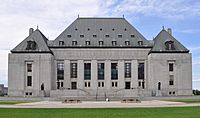R v Drybones facts for kids
Quick facts for kids R v Drybones |
|
|---|---|

|
|
| Hearing: October 28, 1968 Judgment: November 20, 1969 |
|
| Full case name | Her Majesty The Queen v Joseph Drybones |
| Citations | [1970] S.C.R. 282, 1969 CanLII 1 (S.C.C.) |
| Prior history | affirming (1967), 61 W.W.R. 370, [1968] 2 C.C.C. 69, 64 D.L.R. (2d) 260 (N.W.T.C.A.); affirming (1967) 60 W.W.R. 321 (N.W.T.Co. Ct.) |
| Ruling | The appeal should be dismissed. |
| Holding | |
| Section 94(b) of the Indian Act, which makes it a criminal offence for the respondent to do something which his fellow Canadians are free to do without having committed any offence or being made subject to any penalty purely on account of race, is in violation of the respondent's right to equality before the law, protected in Section 1(b) of the Canadian Bill of Rights. Furthermore, an infringing statutory provision that cannot be sensibly construed so as not to infringe the rights enshrined in the Canadian Bill of Rights is inoperative, unless Parliament makes an express declaration that the statutory provision will operate notwithstanding the Canadian Bill of Rights. Therefore, Section 94(b) of the Indian Act is inoperative. | |
| Court membership | |
| Reasons given | |
| Majority | Ritchie J., joined by Fauteux, Martland, Judson, Spence JJ. |
| Concurrence | Hall J., joined by None |
| Dissent | Cartwright C.J., joined by None |
| Dissent | Pigeon J., joined by None |
| Dissent | Abbott J., joined by None |
| Laws applied | |
| Canadian Bill of Rights, 1960 (Can), c. 44, ss. 1(b), 2; Indian Act, R.S.C. 1952, c. 149, s. 94(b). | |
R v Drybones, [1970] S.C.R. 282, was a very important decision by the Supreme Court of Canada. This case said that the Canadian Bill of Rights gave courts the power to stop federal laws that went against its rules. The Supreme Court decided that a part of the Indian Act, called section 94(b), could not be used. This was because it treated people differently based on their background, which was unfair and against the Canadian Bill of Rights.
Before this case, people argued about how much power the Bill of Rights really had. Some thought it was just a guide for understanding laws. Others believed it was a strong law that could overrule other laws made by Parliament. After R v Drybones, the Supreme Court showed that the Bill of Rights had real power to stop unfair laws. However, this specific power was not used again by the Court in the same way.
Because of this important decision, the Canadian Parliament changed the Indian Act. Section 94 was removed in 1971, making laws more fair for everyone.
Contents
What is the Canadian Bill of Rights?
The Canadian Bill of Rights is a law passed in 1960. It was created to protect the basic rights and freedoms of all Canadians. These rights include things like freedom of speech, religion, and the right to be treated equally under the law. It was an early step towards protecting human rights in Canada.
Why was the R v Drybones case important?
The R v Drybones case was important because it was the first time the Supreme Court of Canada used the Canadian Bill of Rights to declare a part of a federal law "inoperative." This means the court said that part of the law could not be used because it violated the rights listed in the Bill of Rights. It showed that the Bill of Rights was more than just a suggestion; it had real legal power.
What was the Indian Act?
The Indian Act is a Canadian law that was first passed in 1876. It has been changed many times since then. This law gives the Canadian government control over many parts of the lives of First Nations people. It also defines who is considered an "Indian" under the law. Over the years, many parts of the Indian Act have been seen as unfair or discriminatory.
How did the Indian Act relate to the case?
In the R v Drybones case, a section of the Indian Act (section 94(b)) was challenged. This section made it against the law for Indigenous people to do something that non-Indigenous people were allowed to do. The Supreme Court found that this was unfair and went against the idea of equality in the Canadian Bill of Rights.
See also
- The Canadian Crown and First Nations, Inuit and Métis
- Canadian Aboriginal case law
- Numbered Treaties
- Indian Act
- Section Thirty-five of the Constitution Act, 1982
- Indian Health Transfer Policy (Canada)

